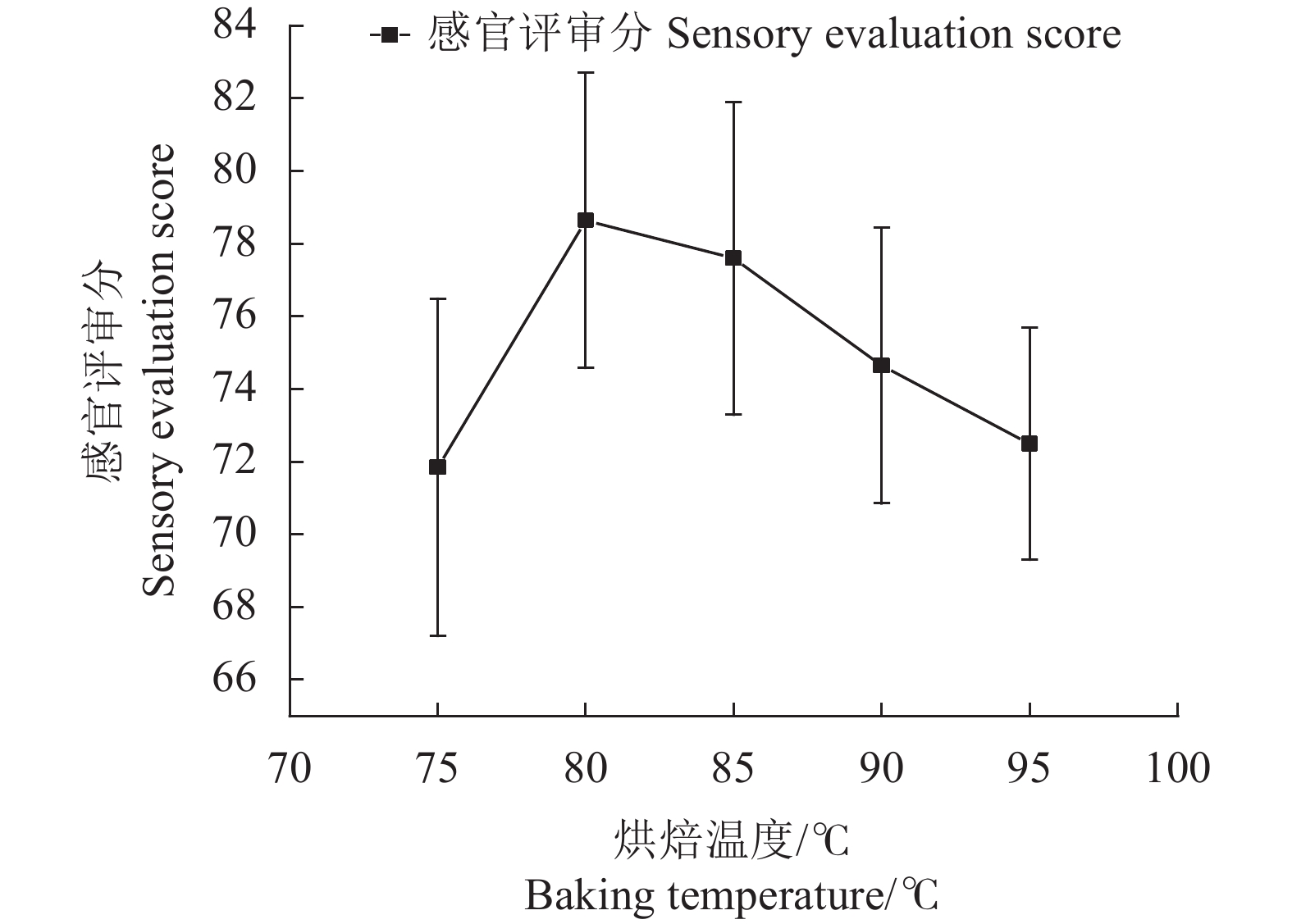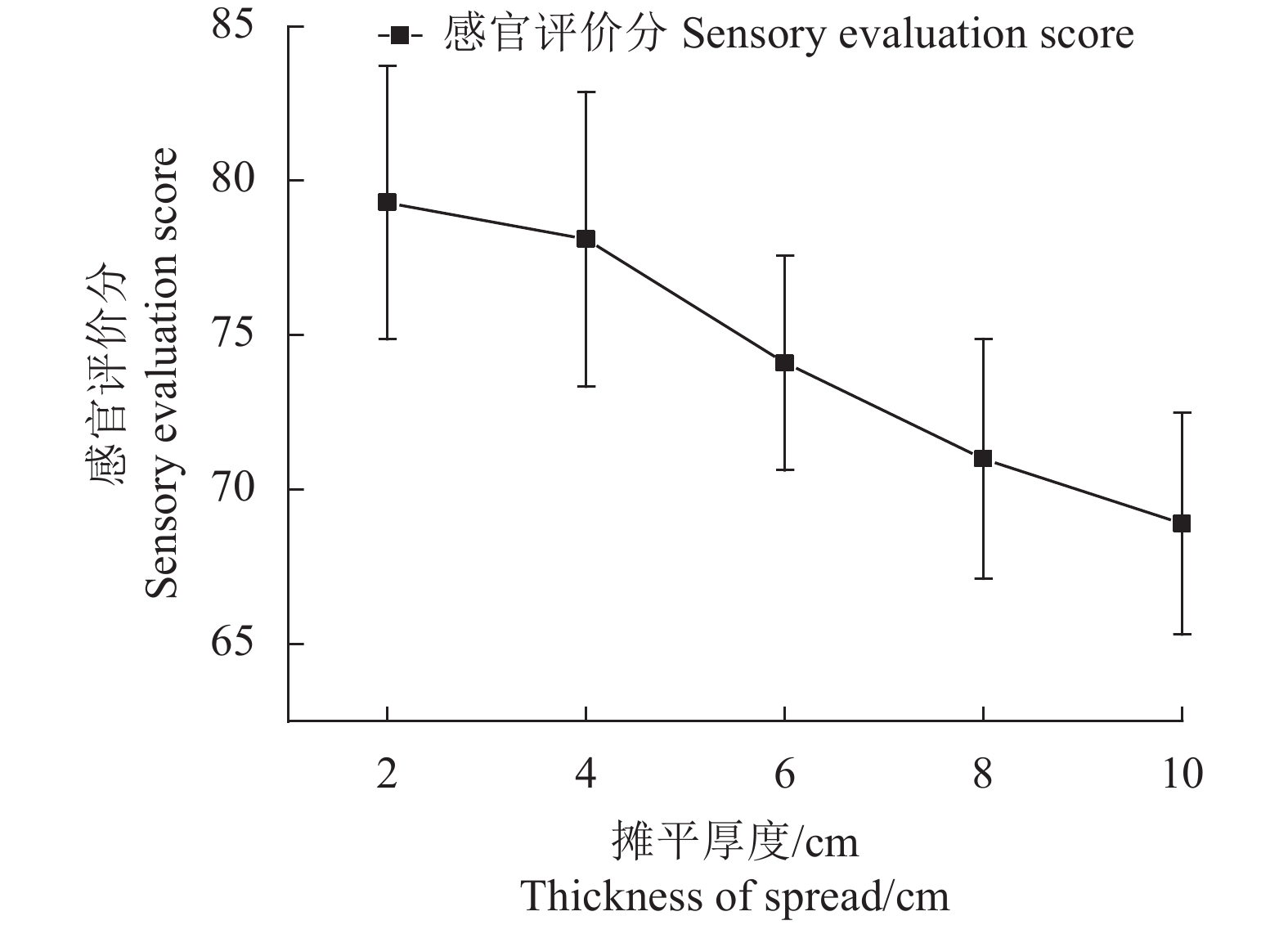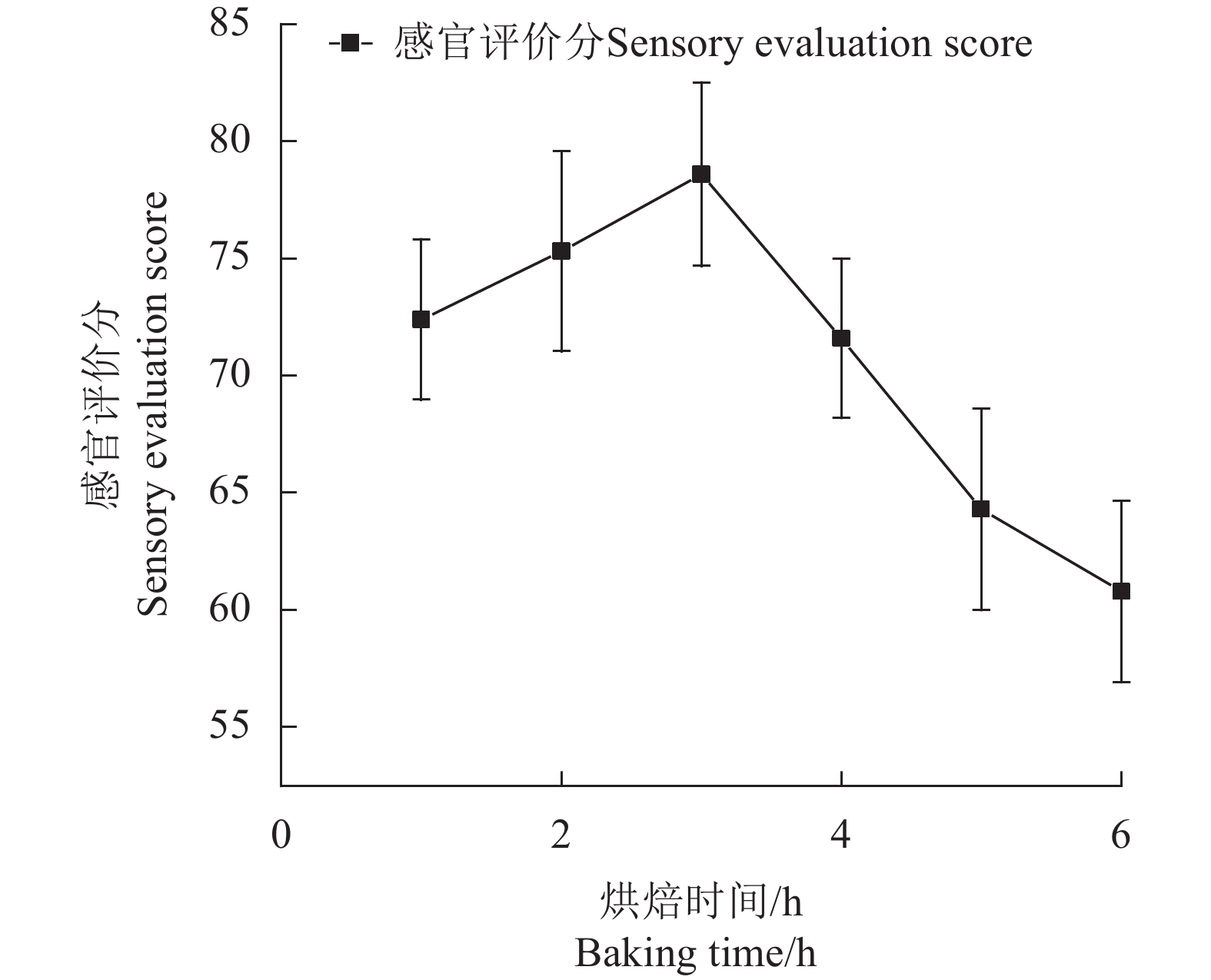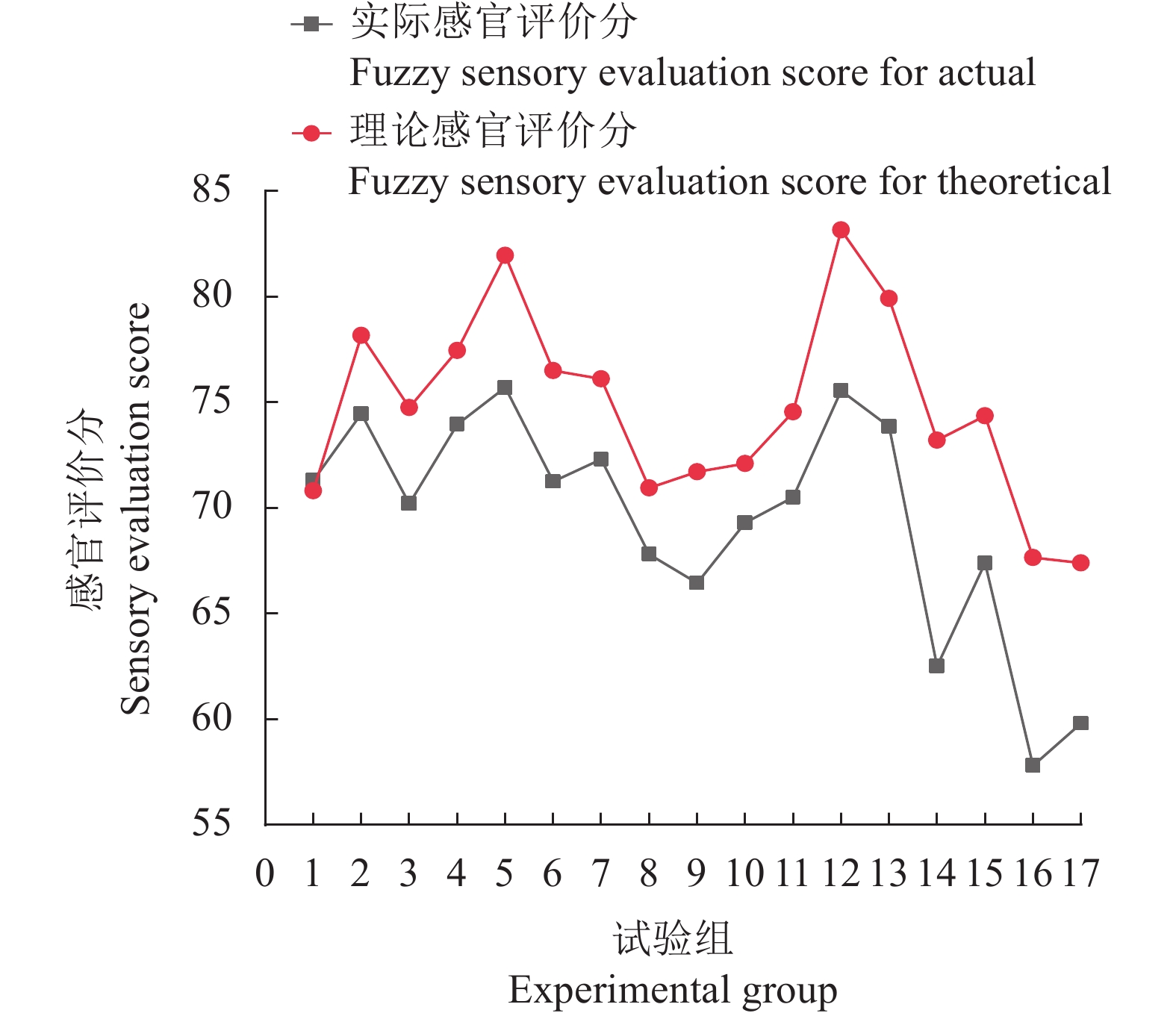Response Surface Optimization of baking parameters for high-quality tea charcoal
-
摘要:
目的 优化茶叶的木炭烘焙工艺,得出最佳木炭烘焙工艺,为高品质茶叶木炭烘焙提供理论参考依据,为茶叶烘焙智能化提供基础。 方法 利用模糊数学矩阵分析原理,以模糊感官综合评价分作为响应值,烘焙温度、摊平厚度、烘焙时间为自变量,设立三因素三水平试验组合,拟合线性回归模型,通过响应面法对茶叶木炭烘焙工艺进行优化,并通过实际烘焙试验进行验证;测量茶叶主要香气成分含量、主要生化成分含量,分析试验工艺对茶叶的品质影响,进一步验证二次回归模型的可靠性。 结果 结合实际修整后的最佳组合参数:烘焙温度为82 ℃、摊平厚度为3 cm、烘焙时间为126 min;茶叶主要香气成分有反-橙花叔醇、法尼烯、植物醇、吲哚,其含量多少与香气等级相符;主要生化成分有茶多酚、可溶性糖、氨基酸、咖啡碱,其含量多少与汤色、滋味等级相符,感官评价结果与评价体系相吻合。 结论 建立的高品质茶叶木炭烘焙工艺的感官评价标准合理,感官评价模型可靠性强,试验结果能够真实地反映木炭烘焙最佳工艺。 Abstract:Objective Using the charcoal baking process conditions of tea leaves as the research object, using the principle of fuzzy mathematical matrix analysis,To optimize the charcoal roasting process for tea leaves and obtain the best charcoal roasting technique,providing a reliable theoretical reference baking high-quality tea leaves and foundation for intelligent tea baking. Methods The fuzzy sensory evaluation score was taken as the response value,and the baking temperature (A),the spreading thickness (B) and the baking time (C) were taken as the independent variables to establish a combination of 3 factors and 3 levels,and a linear regression model was established to optimize the process of tea charcoal baking by response surface methodology.Conduct comparative analysis of actual and theoretical sensory evaluations through actual baking.The analysis of the impact of experimental techniques on the quality of tea further confirms the reliability of the quadratic regression model. Results Based on actual adjustments, the optimal combination parameters are as follows: baking temperature of 82 ℃, spreading thickness of 3 cm, baking time of 126 minutes. The main aroma components of tea include trans orange blossom tert alcohol, farnesene, plant alcohol, and indole, and their content is consistent with the aroma grade; The main biochemical components include tea polyphenols, soluble sugars, amino acids, and caffeine, and their content matches the color and taste level of the soup. The sensory evaluation results are consistent with the evaluation system. Conclusion The sensory evaluation standard of tea is reasonable and the sensory evaluation model is reliable,which can veritable reflect the best process of charcoal baking. -
Key words:
- baking the tea /
- fuzzy mathematics /
- sensory evaluation /
- design-expert response surface
-
表 1 试验因素水平设计方案
Table 1. Design scheme of experimental factor level
因素水平
Factor level烘焙温度
Baking temperature/℃摊平厚度
Thickness of spread/cm烘焙时间
Baking time/h-1 80 2 1 0 85 4 2 1 90 6 3 表 2 茶叶感官评价标准
Table 2. Criteria of tea sensory evaluation
等级
Grade分数范围
Score content外形
Appearance叶底
Brewed tea leaves滋味
Taste汤色
Color of the tea liquids香气
Aroma色泽
Color of tea leaves优
Excellent80~100 肥壮、圆实、重实 肥厚、软亮均整、红边明、有余香 醇厚鲜爽回甘、音韵明显 金黄、清澈 浓郁持久 翠绿、乌润、砂绿明 良
Good60~80 较肥壮、结实 尚软亮、均整、有红边、稍有余香 醇厚、尚鲜爽、音韵明 深金黄、清澈 浓郁持久 乌润、砂绿较明 中
Fair20~60 略肥壮、略结实 稍软亮、略均整 醇和鲜爽、音韵稍明 橙黄、深黄 尚清高 乌润、有砂绿 差
Poor0~20 卷曲、尚结实 稍均整、带褐红色 醇和、音韵轻微 深橙黄、清黄 清纯平正 乌绿、稍带褐红色 表 3 评价茶叶烘干因素权重分布
Table 3. Statistics evaluation of the weight distribution of various factors in tea drying
评选人编号
Selector number外形
Appearance (u1)叶底
Brewed tea leaves (u2)滋味
Taste(u3)香气
Aroma(u4)汤色
Color of the tea liquids(u5)色泽
Color of tea leaves (u6)1 1 2 3 2 2 0 2 1 0 2 2 3 2 3 2 1 3 1 2 1 4 0 1 4 3 1 1 5 1 1 3 3 1 1 6 1 0 3 4 1 1 7 0 1 3 3 2 1 8 1 0 4 1 2 2 9 2 1 3 2 1 1 10 1 1 2 3 1 2 11 2 1 2 2 2 1 12 0 1 4 4 1 0 13 1 2 3 2 1 1 14 1 2 2 3 0 2 15 1 1 2 3 2 1 16 2 1 3 3 1 0 17 1 1 3 2 1 2 18 1 1 4 2 2 0 19 0 1 4 3 1 1 20 1 1 3 2 3 0 总分 Total score 20 20 60 50 30 20 占比 percentage 0.10 0.10 0.30 0.25 0.15 0.10 表 4 不同茶样感官评价等级票数
Table 4. Number of votes of different sensory evaluation grades of tea
样品号
Sample No.外形
Appearance叶底
Brewed tea leaves滋味
Taste香气
Aroma汤色
Color of the tea liquids色泽
Color of the tea leaves优 良 中 差 优 良 中 差 优 良 中 差 优 良 中 差 优 良 中 差 优 良 中 差 1 10 4 6 0 12 4 2 2 8 8 4 0 8 6 6 0 12 4 2 2 10 6 2 2 2 10 2 2 2 10 8 2 0 10 6 4 0 10 8 0 2 12 6 2 0 10 6 4 0 3 10 6 4 0 10 4 4 2 8 6 4 2 8 6 6 0 12 6 2 0 10 6 2 2 4 12 6 0 2 14 4 2 0 8 8 4 0 10 6 4 0 12 4 2 2 8 8 4 0 5 10 4 4 2 12 4 4 0 12 6 2 0 10 8 2 0 12 2 6 0 10 6 4 0 6 10 6 4 0 10 6 4 0 8 6 6 0 10 6 4 0 10 4 6 0 8 6 4 2 7 12 4 4 0 12 6 2 0 8 6 4 2 10 6 4 0 12 4 4 0 10 6 2 2 8 12 6 2 2 12 4 4 0 6 6 6 2 8 6 4 2 8 8 4 0 8 6 4 2 9 10 6 2 2 12 4 4 0 6 6 6 2 6 8 4 2 8 8 2 2 10 6 2 2 10 10 4 6 0 10 4 4 2 8 6 4 2 8 6 6 0 12 4 2 2 10 6 4 0 11 10 4 6 0 10 6 4 0 8 8 2 2 8 6 6 0 12 4 2 2 10 6 2 2 12 10 4 6 0 10 6 4 0 10 6 2 2 10 6 4 0 12 6 2 0 10 8 2 0 13 10 4 6 0 10 6 4 0 10 8 2 0 10 6 2 2 8 8 2 2 10 6 2 2 14 10 4 4 2 10 6 2 2 6 4 6 4 6 8 2 4 6 10 2 2 10 4 4 2 15 10 6 2 2 10 4 6 0 8 6 4 2 6 8 4 2 6 8 4 2 8 6 4 2 16 6 4 8 2 8 8 2 2 4 4 8 4 4 8 4 4 6 8 4 2 6 6 6 2 17 8 6 4 2 8 4 6 2 6 4 6 4 6 8 2 4 4 8 6 2 6 6 6 2 表 5 茶叶烘干条件设计组合
Table 5. Combinational design of tea drying conditions
试验序号
Experiment number烘焙温度(A)
Baking temperature (A)/ ℃摊平厚度(B)
Thickness of spread
(B)/cm烘焙时间(C)
Baking time (C)/h理论模糊感官评价分(F)
Fuzzy sensory evaluation
score for theoretical(F)1 0 −1 −1 71.30 2 0 0 0 74.45 3 0 1 −1 70.20 4 −1 −1 0 73.95 5 0 0 0 75.70 6 1 0 −1 71.25 7 0 0 0 72.30 8 −1 0 −1 67.80 9 1 1 0 66.45 10 −1 0 1 69.30 11 0 −1 1 70.50 12 0 0 0 75.55 13 0 0 0 73.85 14 1 −1 0 62.50 15 −1 1 0 67.40 16 1 0 1 57.80 17 0 1 1 59.80 表 6 响应面二次模型方差分析
Table 6. Variance analysis of the response surface quadratic model
方差来源
Source of variance平方和
Sum of square自由度
Degree of freedom均方
Mean squareF值
F valueP值
P value显著性
Significance模型
Model429.67 9 47.74 16.11 0.0007 ** 烘焙温度A
Baking temperature A52.28 1 52.28 17.64 0.0040 ** 摊平厚度B
thickness of spread B25.92 1 25.92 8.75 0.0212 * 烘焙时间C
Baking time C66.99 1 66.99 22.61 0.0021 ** AB 27.56 1 27.56 9.30 0.0186 * AC 55.88 1 55.88 18.86 0.0034 ** BC 23.04 1 23.04 7.78 0.0270 * A2 70.91 1 70.91 23.93 0.0018 ** B2 30.50 1 30.50 10.29 0.0149 * C2 58.54 1 58.54 19.76 0.0030 ** 残差
Residual20.74 7 2.96 失拟项
Lack of fit13.02 3 4.34 2.25 0.2251 纯误差
Pure error7.72 4 1.93 合计
Cor total450.41 16 R2=0.9540 R2Adj=0.8948 CV=2.48% **为差异极显著(P<0.01);*为差异显著(0.01<P<0.05)。
** means the difference is extremely significant (P < 0.01); * the difference is significant (0.01<P<0.05).表 7 不同试验茶叶主要香气成分含量
Table 7. Main aroma components of different tea samples
试验序号
Experiment number反-橙花叔醇
Trans-nerolidol/%植物醇
Phytosterol/%法尼烯
Farnesene/%吲哚
Indole/%实际模糊感官评价分(F)
Fuzzy sensory evaluation score for actual (F)1 13.28±0.29 efg 6.20±0.32 ef 8.24±0.38 bcde 4.66±0.15 ef 70.80 2 14.29±0.25 cd 7.37±0.33 cde 7.23±0.34 f 4.32±0.17 efg 78.15 3 12.99±0.27 g 6.19±0.25 f 8.26±0.28 bcde 5.16±0.26 d 74.75 4 13.92±0.39 cde 7.03±0.32 d 7.89±0.25 e 3.52±0.14 h 77.45 5 15.34±0.49 b 5.92±0.26 ef 7.92±0.37 de 3.12±0.13 h 81.95 6 13.58±0.30 defg 6.15±0.27 ef 8.61±0.23 bcde 3.34±0.15 h 76.5 7 14.10±0.24 cde 6.05±0.31 ef 8.08±0.16 cde 3.82±0.18 gh 76.10 8 12.07±0.23 hi 7.70±0.29 abcd 8.47±0.39 bcde 5.88±0.29 c 70.95 9 11.86±0.15 hij 7.86±0.30 abcd 8.31±0.30 bcde 6.22±0.29 bc 71.7 10 13.10±0.23 efg 6.00±0.29 ef 8.41±0.35 bcde 5.23±0.20 d 72.1 11 13.19±0.37 efg 7.88±0.12 abcd 8.05±0.36 cde 5.28±0.39 d 74.55 12 16.09±0.25 ab 6.09±0.27 ef 7.37±0.14 f 3.99±0.19 fg 83.15 13 14.06±0.54 cde 7.64±0.34 abcd 7.25±0.29 f 3.33±0.18 h 79.90 14 11.35±0.31 ij 7.70±0.35 abcd 8.36±0.31 bcde 7.33±0.36 a 73.20 15 12.18±0.52 hi 8.11±0.43 abcd 8.20±0.35 bcde 6.49±0.31 b 74.35 16 10.36±0.49 k 7.92±0.35 abcd 9.66±0.39 a 7.49±0.30 a 67.65 17 11.19±0.41 j 7.52±0.38 bcd 8.30±0.36 bcde 7.58±0.29 a 67.4 18 15.78±0.67 ab 5.90±0.27 ef 6.90±0.19 f 4.44±0.22 ef 82.50 表中同列数据后不同小写字母表示差异显著 (P<0.05)。表8同。
Different lowercase letters in the same column in the table indicate significant differences in content (P<0.05). Same for Table 8.表 8 不同试验茶叶主要生化成分含量
Table 8. Main biochemical components of different tea samples
试验序号
Experiment number茶多酚
Tea polyphenol/%可溶性糖
Soluble sugar/%氨基酸
Amino acid/%咖啡碱
Caffeine/%1 23.59±0.82 c 5.83±0.25 defgh 1.73±0.12 hij 1.98±0.08 ij 2 24.87±0.51 b 6.23±0.30 bcd 2.04±0.07 f 1.53±0.07 k 3 23.61±0.44 c 5.71±0.15 defg 1.80±0.03 gh 2.35±0.12 h 4 24.82±0.31 b 5.63±0.28 defg 2.38±0.12 e 1.97±0.09 ij 5 26.22±0.36 a 5.60±0.26 defg 3.18±0.13 c 1.24±0.06 l 6 23.51±0.46 c 5.77±0.17 defg 1.74±0.07 ghi 2.03±0.07 ij 7 24.01±0.38 c 5.77±0.31 defg 2.26±0.11 e 1.97±0.09 ij 8 21.24±0.48 d 6.21±0.22 bcde 1.59±0.03 ijk 3.04±0.13 fg 9 21.81±0.49 d 5.52±0.25 efgh 1.45±0.07 ijk 3.36±0.12 e 10 23.24±0.44 c 5.84±0.25 cdefg 1.76±0.09 gh 3.15±0.10 fg 11 23.61±0.41 c 6.00±0.22 bcde 1.83±0.09 gh 2.95±0.10 g 12 26.57±0.86 a 6.64±0.26 a 3.55±0.10 a 1.09±0.05 l 13 24.83±0.42 b 5.90±0.14 cdefg 2.57±0.09 d 1.80±0.07 j 14 20.03±0.55 ef 5.19±0.16 hi 1.36±0.11 k 4.20±0.21 c 15 21.65±0.34 d 5.47±0.09 efgh 1.60±0.04 hijk 3.84±0.09 d 16 18.84±0.41 f 4.64±0.10 k 1.06±0.06 l 4.78±0.17 a 17 19.31±0.35 ef 5.05±0.15 i 1.21±0.04 l 4.52±0.15 b 18 26.00±0.37 a 6.22±0.32 bcd 3.39±0.13 b 1.44±0.06 k 表中同一列不同小写字母表示含量存在差异显著(P<0.05)。
Different lowercase letters in the same column in the table indicate significant differences in content (P<0.05). -
[1] 国家统计局. 2023年国民经济和社会发展统计公报[EB/OL]. [2024-02-29]. https://www.stats.gov.cn/sj/zxfb/202402/t20240228_1947915.html. [2] 刘志, 张永志, 周铁锋, 等. 不同烘干方式对茶叶中稳定同位素特征及其产地溯源的影响 [J]. 核农学报, 2018, 32(7):1408−1416. doi: 10.11869/j.issn.100-8551.2018.07.1408LIU Z, ZHANG Y Z, ZHOU T F, et al. Effects of different drying techniques on stable isotopic characteristics and traceability of tea [J]. Journal of Nuclear Agricultural Sciences, 2018, 32(7): 1408−1416. (in Chinese) doi: 10.11869/j.issn.100-8551.2018.07.1408 [3] 操晓亮, 张峰, 柴国璧, 等. 基于感官导向的铁观音茶叶特征香气的分析、重构及在卷烟加香中的应用 [J]. 中国烟草学报, 2021, 27(4):10−19.CAO X L, ZHANG F, CHAI G B, et al. Analysis and reconstitution of characteristic aromas in Tie Guanyin tea based on sensory-oriented separation and its application in cigarette flavoring [J]. Acta Tabacaria Sinica, 2021, 27(4): 10−19. (in Chinese) [4] 项应萍, 徐邢燕, 刘国英, 等. 乌龙茶烘焙技术研究进展 [J]. 亚热带农业研究, 2019, 15(3):211−216.XIANG Y P, XU X Y, LIU G Y, et al. Research advances in oolong tea baking technology [J]. Subtropical Agriculture Research, 2019, 15(3): 211−216. (in Chinese) [5] 谢振邦. 闽南乌龙茶烘焙技术初探 [J]. 南方农业, 2019, 13(6):81−83.XIE Z B. Preliminary study on baking technology of Minnan oolong tea [J]. South China Agriculture, 2019, 13(6): 81−83. (in Chinese) [6] 苏成家. 不同焙火工艺对乌龙茶品质的影响 [J]. 现代食品, 2018, (15):167−169,174.SU C J. Effects of different roasting processes on oolong tea quality [J]. Modern Food, 2018(15): 167−169,174. (in Chinese) [7] 高育森, 任金波, 李梅娟, 等. 基于模糊PID控制的茶叶炭焙烘焙机设计与试验 [J]. 食品与机械, 2021, 37(3):96−101.GAO Y S, REN J B, LI M J, et al. Design and test of tea charcoal roasting machine based on fuzzy PID control [J]. Food & Machinery, 2021, 37(3): 96−101. (in Chinese) [8] 俞梦瑶, 禹利君, 徐帅, 等. 不同烘干处理对茶叶中霉菌的控制及感官品质的影响 [J]. 茶叶通讯, 2020, 47(2):267−274.YU M Y, YU L J, XU S, et al. Effects of different drying treatments on the control of mould in tea and the sensory quality of tea [J]. Journal of Tea Communication, 2020, 47(2): 267−274. (in Chinese) [9] 徐文娟. 基于DCS的茶叶烘干机工艺监控研究 [J]. 农机化研究, 2020, 42(10):239−242.XU W J. Research of monitoring system on tea drying process based on DCS [J]. Journal of Agricultural Mechanization Research, 2020, 42(10): 239−242. (in Chinese) [10] 赵丽清, 段东瑶, 殷元元, 等. 基于PSO-Elman算法的茶叶烘干含水率预测 [J]. 农业工程学报, 2021, 37(19):284−292.ZHAO L Q, DUAN D Y, YIN Y Y, et al. Prediction of tea drying moisture content based on PSO Elman algorithm [J]. Transactions of the Chinese Society of Agricultural Engineering, 2021, 37(19): 284−292. (in Chinese) [11] 赵合胜. 基于灰色预测和SVM的茶叶烘焙温湿度预测 [J]. 西安文理学院学报(自然科学版), 2018, 21(5):64−67.ZHAO H S. Prediction of the baking temperature and humidity of tea based on grey prediction and support vector machine(SVM) [J]. Journal of Xi’an University (Natural Science Edition), 2018, 21(5): 64−67. (in Chinese) [12] WANG C, LI J, ZHANG Y, et al. Effects of electrostatic spray drying on the sensory qualities, aroma profile and microstructural features of instant Pu-erh tea[J]. Food Chemistry, 2022, 373(Pt B): 131546. [13] HAN J H, KIM D, CHUN J Y. Effect of thickness and drying method on properties of dried tangerine tea [J]. Journal of the Korean Society of Food Science and Nutrition, 2022, 51(3): 245−253. doi: 10.3746/jkfn.2022.51.3.245 [14] PASHAZADEH H, ZANNOU O, KOCA I. Modeling and optimization of drying conditions of dog rose for preparation of a functional tea [J]. Journal of Food Process Engineering, 2021, 44(3): e13632. doi: 10.1111/jfpe.13632 [15] STIEFENHOFER P. Evaluating pedagogical quality of learning activities using fuzzy evaluation mappings: The case of pedagogical games of mathematical proof [J]. Applied Mathematics, 2022, 13(5): 432−452. doi: 10.4236/am.2022.135029 [16] ATAEI NUKABADI F, HOJJATOLESLAMY M, ABBASI H. Optimization of fortified sponge cake by nettle leaves and milk thistle seed powder using mixture design approach [J]. Food Science & Nutrition, 2020, 9(2): 757−771. [17] OMAR S M, ABDALLA F I, ABDELGAWAD N M. Preparation and optimization of fast-disintegrating tablet containing naratriptan hydrochloride using D-optimal mixture design [J]. AAPS PharmSciTech, 2018, 19(6): 2472−2487. doi: 10.1208/s12249-018-1061-9 [18] RIVERO R C, ARCHAINA D A, BUSQUET C M, et al. Development of a honey-based powder ingredient using a mixture design: Botanical origin effect and hydration properties [J]. LWT, 2021, 147: 111446. doi: 10.1016/j.lwt.2021.111446 [19] 刘加友, 陈兵兵, 王振斌, 等. 模糊数学和响应面在葛根乳酸菌饮料感官评定中的应用 [J]. 中国食品学报, 2017, 17(1):224−229.LIU J Y, CHEN B B, WANG Z B, et al. Application of fuzzy mathematics and response surface in sensory assessment of kudzu root beverage [J]. Journal of Chinese Institute of Food Science and Technology, 2017, 17(1): 224−229. (in Chinese) [20] 崔立柱, 付依依, 刘士伟, 等. 基于模糊数学感官评价法沙棘饼干烘焙工艺优化 [J]. 食品工业科技, 2021, 42(15):163−169.CUI L Z, FU Y Y, LIU S W, et al. Optimization for baking process of sea-buckthorn biscuits based on sensory evaluation of fuzzy mathematics [J]. Science and Technology of Food Industry, 2021, 42(15): 163−169. (in Chinese) [21] 崔莉, 李大婧, 高小女, 等. 基于模糊数学感官评价和混料设计的低度甜糯玉米酒原料配方优化[J]. 核农学报, 2015, 29(1): 106-112.CUI L, LI DJ, LIU CQ, et al. Mixture design of maize wine raw material recipe based on fuzzy mathematic sensory evaluation[J]. Journal of Nuclear Agricultural Sciences, 2015, 29: 106-112. (in English) CUI L, LI D J, GAO X N, et al. Mixture design of maize wine raw material recipe based on fuzzy mathematic sensory evaluation[J]. Journal of Nuclear Agricultural Sciences, 2015, 29(1): 106-112. (in Chinese) [22] 钟凯, 罗易萍, 张天天, 等. 基于模糊数学法复合茯砖茶饮料配方优化及其香气品质分析 [J]. 茶叶通讯, 2021, 48(1):114−123.ZHONG K, LUO Y P, ZHANG T T, et al. Formulation optimization and aroma quality analysis of compound fuzhuan brick tea beverage based on fuzzy mathematics [J]. Journal of Tea Communication, 2021, 48(1): 114−123. (in Chinese) [23] SUN J F, YANG T S, LIU Q, et al. Optimization of key technology for instant sea cucumber processing through fuzzy evaluation and response surface methodology [J]. American Journal of Biochemistry and Biotechnology, 2017, 13(2): 99−110. doi: 10.3844/ajbbsp.2017.99.110 [24] 中华人民共和国国家质量监督检测检疫总局, 中国国家标准化管理委员会. 茶叶分类: GB-T 30766-2014 [S]. 北京: 中国标准出版社, 2014. [25] 盛金凤, 王雪峰, 雷雅雯, 等. 干燥温度和切片厚度对柿子片干燥特性与品质影响 [J]. 食品研究与开发, 2022, 43(3):58−65.SHENG J F, WANG X F, LEI Y W, et al. Effect of temperature and thickness on the drying characteristics and quality of persimmon slices [J]. Food Research and Development, 2022, 43(3): 58−65. (in Chinese) [26] 朱燕芳, 郝燕, 陈建军, 等. 河西走廊葡萄叶幕厚度对果实品质的影响 [J]. 中外葡萄与葡萄酒, 2022, (6):71−75.ZHU Y F, HAO Y, CHEN J J, et al. Effects of canopy thickness of grapevine on berry quality in Hexi corridor [J]. Sino-Overseas Grapevine & Wine, 2022(6): 71−75. (in Chinese) [27] 张璐, 熊双丽, 李安林, 等. 油炸温度和时间对小酥肉品质的影响[J/OL]. 食品工业科技: 1-124-03-11]. https: //doi. org/10.13386/j. issn1002-0306.2023050031. ZHANG L, XIONG S L, LI A L, et al. Effect of frying temperature and time on the quality of small crispy meat[J/OL]. Science and Technology of Food Industry: 1-12[2024-03-11]. https://doi.org/10.13386/j.issn1002-0306.2023050031. [28] 孙晓慧, 陈兰海, 刘娟, 等. 不同焙烤温度和时间对榛子坚果果仁品质的影响 [J]. 安徽农业科学, 2021, 49(21):184−188.SUN X H, CHEN L H, LIU J, et al. Effects of different baking temperature and time on kernel quality of hazelnut nut [J]. Journal of Anhui Agricultural Sciences, 2021, 49(21): 184−188. (in Chinese) [29] 毕继才, 林泽原, 李洋, 等. 基于模糊数学综合评价法优化椒麻鸡片调理食品的开发 [J]. 中国调味品, 2021, 46(2):93−96,101.BI J C, LIN Z Y, LI Y, et al. Optimization of prepared food of chicken slices with pepper based on fuzzy mathematics compound evaluation method [J]. China Condiment, 2021, 46(2): 93−96,101. (in Chinese) [30] 国家质量监督检验检疫总局, 中国国家标准化管理委员会. 茶叶感官审评方法: GB/T 23776—2018[S]. 北京: 中国标准出版社, 2018. [31] 国家质量监督检验检疫总局, 中国国家标准化管理委员会. 茶叶感官审评术语: GB/T 14487—2017[S]. 北京: 中国标准出版社, 2017. [32] 邵蕾, 许铭强, 孟新涛, 等. 模糊数学感官评价与响应面法优化法兰西西梅静磁场解冻工艺 [J]. 食品安全质量检测学报, 2022, 13(22):7381−7390.SHAO L, XU M Q, MENG X T, et al. Optimization of magnetic field thawing process of Prunus domestica L. by fuzzy mathematical sensory evaluation and response surface method [J]. Journal of Food Safety & Quality, 2022, 13(22): 7381−7390. (in Chinese) [33] 刘士伟, 王成祥, 段盛林, 等. 基于模糊数学感官评价的杂粮馒头配方优化及低GI验证 [J]. 食品工业科技, 2022, 43(21):375−380.LIU S W, WANG C X, DUAN S L, et al. Research on formula optimization and low-GI verification of coarse grain steamed bread based on fuzzy mathematics sensory evaluation [J]. Science and Technology of Food Industry, 2022, 43(21): 375−380. (in Chinese) [34] 郑玲燕, 杨婷婷, 王旭, 等. 基于感官评价的常见菜心品质分级方法建立 [J]. 食品安全质量检测学报, 2023, 14(4):50−56.ZHENG L Y, YANG T T, WANG X, et al. Establishment of quality grading method of common flowering Chinese cabbage based on sensory evaluation [J]. Journal of Food Safety & Quality, 2023, 14(4): 50−56. (in Chinese) [35] 张剑林, 殷娜, 陈言镕, 等. 模糊数学评价法优化驴乳奶啤稳定性的预处理参数及香气成分分析 [J]. 中国酿造, 2021, 40(1):75−81.ZHANG J L, YIN N, CHEN Y R, et al. Optimization of pretreatment parameters of donkey milk beer stability and aroma components analysis with fuzzy mathematics evaluation [J]. China Brewing, 2021, 40(1): 75−81. (in Chinese) [36] 王瑞花, 张文娟, 陈健初, 等. 基于模糊数学综合评价法优化红烧肉制作工艺 [J]. 食品工业科技, 2015, 36(6):274−278.WANG R H, ZHANG W J, CHEN J C, et al. Optimization of braised pork processing based on fuzzy mathematic evaluation [J]. Science and Technology of Food Industry, 2015, 36(6): 274−278. (in Chinese) [37] 陈林, 林清霞, 张应根, 等. 不同风味类型铁观音乌龙茶香气组成化学模式识别研究 [J]. 茶叶科学, 2018, 38(3):253−262.CHEN L, LIN Q X, ZHANG Y G, et al. Aroma profiling of tieguanyin oolong tea with different flavor characteristics based on chemical pattern recognition [J]. Journal of Tea Science, 2018, 38(3): 253−262. (in Chinese) [38] 国家质量监督检验检疫总局, 中国国家标准化管理委员会. 茶 游离氨基酸总量的测定: GB/T 8314—2013[S]. 北京: 中国标准出版社, 2014. [39] 国家市场监督管理总局, 国家标准化管理委员会. 茶叶中茶多酚和儿茶素类含量的检测方法: GB/T 8313—2018[S]. 北京: 中国标准出版社, 2018. [40] 罗红玉, 王奕, 吴全, 等. 光质萎凋对不同茶树品种红茶品质的影响 [J]. 食品工业科技, 2021, 42(10):15−21.LUO H Y, WANG Y, WU Q, et al. Effect of withering light-wave bands on different varieties black tea quality [J]. Science and Technology of Food Industry, 2021, 42(10): 15−21. (in Chinese) [41] 国家质量监督检验检疫总局, 中国国家标准化管理委员会. 茶 咖啡碱测定: GB/T 8312—2013[S]. 北京: 中国标准出版社, 2014. [42] 聂攀, 曾辉, 陆军, 等. 焙烤温度对藜麦理化特性的影响 [J]. 食品研究与开发, 2022, 43(14):105−111.NIE P, ZENG H, LU J, et al. Effects of baking temperature on the physicochemical properties of quinoa [J]. Food Research and Development, 2022, 43(14): 105−111. (in Chinese) [43] 王丹, 况丹妮, 刘若阳, 等. 焦糖化与美拉德反应中DDMP、HMF及糠醛的生成研究 [J]. 食品工业科技, 2022, 43(12):100−107.WANG D, KUANG D N, LIU R Y, et al. Formation of DDMP, HMF and furfural in caramelization and Maillard reaction [J]. Science and Technology of Food Industry, 2022, 43(12): 100−107. (in Chinese) [44] 丛懿洁, 张慧云. 模糊数学法结合响应面法优化木糖醇无花果桑葚果粒酸奶工艺 [J]. 食品研究与开发, 2021, 42(2):127−135.CONG Y J, ZHANG H Y. Optimization of fermentation process of xylitol fig mulberry fruit yogurt using fuzzy mathematics method combined with response surface method [J]. Food Research and Development, 2021, 42(2): 127−135. (in Chinese) [45] 舒心, 高彦祥. 茶叶挥发性成分提取及其香气特征分析研究进展 [J]. 食品工业科技, 2022, 43(15):469−480.SHU X, GAO Y X. Research progress on extraction of volatile compounds and analysis of aroma characteristics in tea [J]. Science and Technology of Food Industry, 2022, 43(15): 469−480. (in Chinese) [46] 占琪, 任洪涛, 杨雪梅, 等. 电焙和炭焙武夷岩茶与常规烘焙铁观音香气成分分析 [J]. 云南农业大学学报(自然科学), 2018, 33(1):113−119.ZHAN Q, REN H T, YANG X M, et al. Analysis on the aroma components in Wuyi rock tea with baking of electric and charcoal and conventional baking tieguanyin oolong tea [J]. Journal of Yunnan Agricultural University (Natural Science), 2018, 33(1): 113−119. (in Chinese) [47] 郑慕蓉, 谢寿桂, 秦荣基, 等. 基于仿宋斗茶与茶叶感官审评的茶叶品质对比评价 [J]. 武夷学院学报, 2024, 43(1):54−62.ZHENG M R, XIE S G, QIN R J, et al. Analysis on the quality evaluation of the tea in imitating of song dynasty tea competition and modern tea sensory evaluation [J]. Journal of Wuyi University, 2024, 43(1): 54−62. (in Chinese) [48] 金山峰, 王冬欣, 黄俊仕, 等. 基于计算机视觉的茶叶品质在线评价系统 [J]. 食品工业科技, 2021, 42(14):219−225.JIN S F, WANG D X, HUANG J S, et al. Online evaluation system of tea quality based on computer vision [J]. Science and Technology of Food Industry, 2021, 42(14): 219−225. (in Chinese) [49] 牛帅. 绿茶品质风味嗅觉味觉双通道感知方法研究[D]. 镇江: 江苏大学, 2021.NIU S. Study on olfactory and gustatory dual channel perception method for green tea quality and flavor[D]. Zhenjiang: Jiangsu University, 2021. (in Chinese) -








 下载:
下载:





